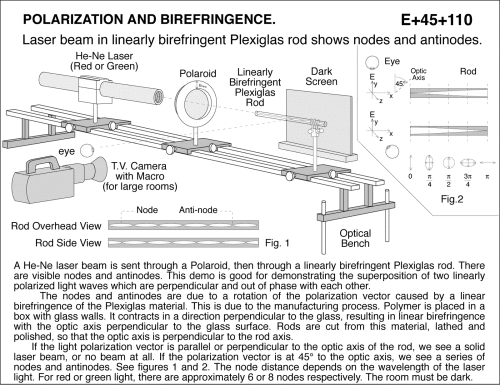Visible nodes and antinodes in linearly birefringent plexiglass rod.
Primary tabs
Laser beam in linearly birefringent Plexiglas rod shows nodes and antinodes. A He-Ne laser beam is sent through a Polaroid, then through a linearly birefringent Plexiglas rod. There are visible nodes and antinodes. This demo is good for demonstrating the superposition of two linearly polarized light waves which are perpendicular and out of phase with each other. The nodes and antinodes are due to a rotation of the polarization vector caused by a linear birefringence of the Plexiglas material. This is due to the manufacturing process. Polymer is placed in a box with glass walls. It contracts in a direction perpendicular to the glass, resulting in linear birefringence with the optic axis perpendicular to the glass surface. Rods are cut from this material, lathed and polished, so that the optic axis is perpendicular to the rod axis. If the light polarization vector is parallel or perpendicular to the optic axis of the rod, we see a solid laser beam, or no beam at all. If the polarization vector is at 45 deg to the optic axis, we see a series of nodes and antinodes. See figures 1 and 2. The node distance depends on the wavelength of the laser light. For red or green light, there are approximately 6 or 8 nodes respectively. The room must be dark.
UCB Index:
E+45+110
PIRA Index:
6H35.17
UCB Taxonomy:
PIRA Taxonomy:
Popularity:
- Log in to post comments

